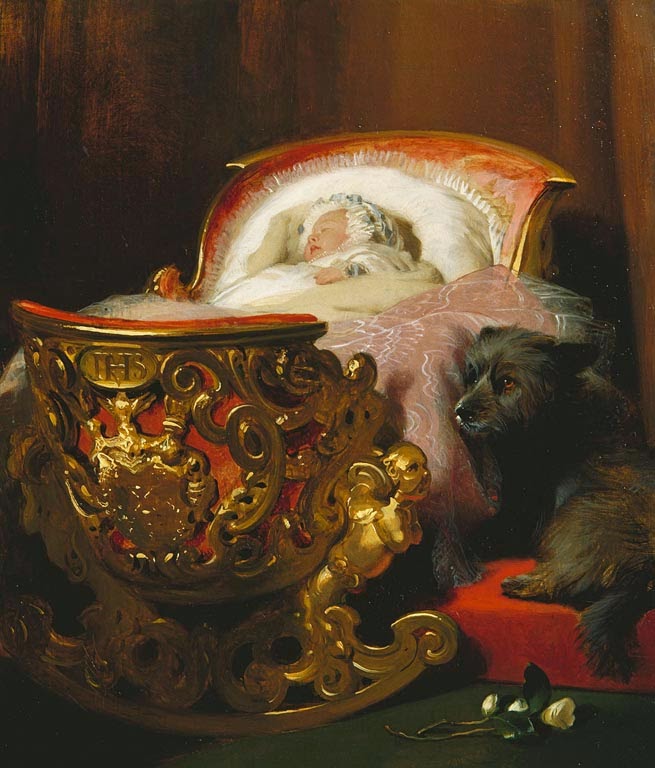At Windsor one of Prince Albert's official titles was Ranger of the Great Park. Sir Edwin Landseer painted him in that role as if the Prince had just arrived home from a day in the forest with a display of dead birds to arrange on the newly fitted carpet and satin upholstery of the White Drawing Room. The artist took particular care with individualized portraits of the family dogs. Also included was the tiny Princess Royal at far left, playing with the corpse of a kingfisher. Eos the favorite greyhound occupied the preeminent position nearest to Albert.
Eos was no stranger to posing. Landseer had already painted him alone, standing guard over Albert's hat, gloves, and stick (note the little ottoman covered in deerskin, with actual deer-feet supplied by the taxidermist). The dear dog also featured prominently in Baby Victoria's first portrait (below) where a living bird – a turtle dove – perched on the ever-present green satin upholstery.
Two years later it was the turn of the newest baby, Princess Alice, to be painted in her cradle at the age of nine days. As guard dog, Landseer this time substituted Dandie Dinmont, the same Skye terrier who was attempting to climb into Albert's lap in the top picture. The brown Skye terrier on the floor in that picture, lifting its beseeching little paws, was the Queen's favorite, Islay.
Landseer also featured Islay in the multiple pet portrait (below) that included a pair of uncaged lovebirds and a crumpet-eating macaw.
As must be obvious, this artist's fame rested very largely on meticulous representations of fur and feathers.
Names of all dogs were carefully recorded on the backs of paintings. The Queen also owned Landseer's picture of Brazilian marmosets clinging to a pineapple, though there is no firm agreement as to whether or not she owned the marmosets themselves.
When the American lion tamer Isaac van Amberg came to London and created a sensation in 1839, Victoria arranged for Landseer to paint him reclining among his snarling beasts. She also commissioned the Highlander (below) with dead eagle dangling from giant fist.
Dead animals and Scotland seem to have been inextricably associated in Queen Victoria's mind. Landseer portrayed her not once but twice (below) contemplating enormous and recently killed stags, destined (at least in theory) for her larder.
The subtext of Landseer's work seems to acknowledge broader associations – such as the inevitable link between Empire and violence.










